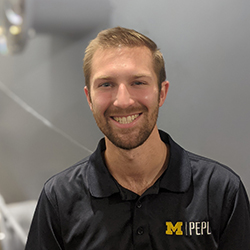
University of Michigan’s Plasmadynamics and Electric Propulsion Laboratory and NASA Jet Propulsion Laboratory share 2022 AIAA Electric Propulsion Best Paper Award
The lab has won this award five times in the last six years

The lab has won this award five times in the last six years
University of Michigan Department of Aerospace Engineering Doctoral Candidate Parker Roberts (lead author) and Associate Professor Benjamin Jorns have won the 2022 AIAA “Best Paper in Electric Propulsion” award for their manuscript titled “Experimental Characterization of Wave-Induced Azimuthal Ion Velocities in a Hollow Cathode Plume.” Roberts and Jorns share the award with Dr. Vernon Chaplin, a senior technologist in the Electric Propulsion Group at the Jet Propulsion Laboratory.


The work, which was supported by a grant from the NASA Space Technology Mission Directorate, describes the results of experiments to investigate mechanisms which reduce the operational lifetime of Hall thrusters. These devices are a type of electric plasma rocket that is widely used for commercial applications and deep-space exploration. Understanding and mitigating wear mechanisms in these devices could enable the use of Hall thrusters on even more ambitious missions beyond cislunar space. Working under Dr. Chaplin and Prof. Jorns, Roberts applied an advanced diagnostic technique known as time-resolved laser-induced fluorescence to measure the impact of coherent plasma waves on the generation of energetic ions in the electron source, the hollow cathode, of a Hall effect thruster. It is believed that wave-driven energetic ions waves may lead to bombardment of the thruster surface and cause erosion. Further investigations of this correlation could provide an avenue to reduce the wear rate of Hall thruster components and extend their lifetimes.
As lead author, Roberts is pleased his research has been recognized by esteemed colleagues at AIAA. He hopes to continue this work, with the goal of improving the design of Hall thruster cathodes to mitigate the instabilities investigated in the awarded paper. If successful, this effort will result in the extension of Hall thruster lifetimes, so that they can be used to efficiently power deep-space exploration missions spanning many years.
Roberts joined PEPL in the fall of 2020 as a Ph.D. student in Aerospace Engineering. Before this, he spent two summers working with the Jet Propulsion Laboratory on validation testing of the Hall-Effect Rocket with Magnetic Shielding (HERMeS) for the Lunar Gateway spacecraft. His current research focuses on investigating particle transport, oscillations, and facility effects in high-power Hall thrusters using non-invasive laser plasma diagnostics including laser-induced fluorescence and incoherent Thomson scattering. Roberts is a recipient of a 2020 NASA Space Technology Graduate Research Opportunity award.
This is the fifth AIAA best paper award for Jorns who has been the lead author or co-author on five of the last six winning manuscripts. Jorns left the electric propulsion group at NASA JPL in 2016 to join the University of Michigan faculty where he is co-director of the Plasmadynamics and Electric Propulsion Laboratory. His main research interests include the study of mechanisms and stability in electric propulsion systems, turbulence and non-linear processes in low-temperature plasmas, and developing new plasma diagnostics and breakthrough forms of in-space propulsion. Jorns is an associate fellow of the AIAA and has received among other awards the 2021 AIAA Lawrence Sperry Award, the Department of Energy Early Career Research Award, and an AFOSR Young Investigator Program award. Jorns also serves as co-director of the NASA Joint Advanced Propulsion Institute.